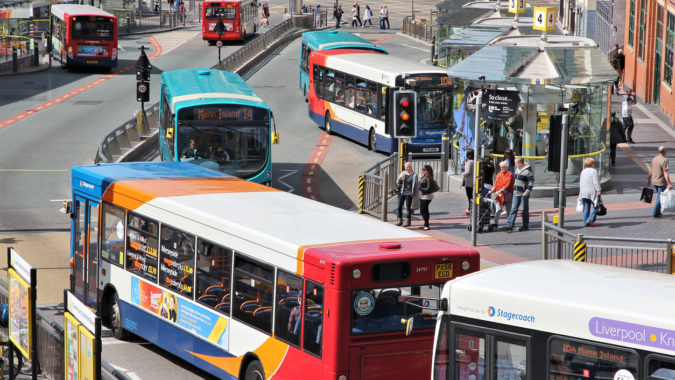James Heath, Chief Executive of the National Infrastructure Commission, gave a keynote address at the Northern Transport Summit held in Liverpool today (23 February 2023).
In his remarks, James stresses the importance of investing in a more resilient rail service for the North, before outlining the Commission’s approach to analysing the specific role transport modes can play in boosting economic productivity.
The most effective solutions differ between more local urban transport and longer distance inter-urban routes, James explains, setting out areas where the Commission will give further advice to government in the second National Infrastructure Assessment, to be published this autumn.
The full text of James’ speech can be found below.
The theme of this summit – ‘connecting people and places in the North – and levelling up transport’ – is hugely important. I imagine that most of us in this room rely on transport in one form or another in our daily lives. On average, each person in England made over 750 trips across all transport modes in 2021, despite the disruptions.
But these direct benefits to us as transport users are dwarfed, in economic terms at least, by the wider returns to places from transport’s role in shaping business investment and location decisions. Each city and region in the North has different economic strengths and strategic opportunities that transport can help to unlock. Our railways and roads are a means – economic growth is the end. And it is transport’s role in increasing the productivity and competitiveness of the North’s cities and towns that I will focus on.
Our starting point at the Commission is that travel is generally a good thing that should be supported – not a bad thing that should be supressed. If we want to reduce the regional economic disparities in this country, then we’ll almost certainly need to increase trips into many of the cities and towns in the North.
But we also know that some trips have negative side effects in terms of carbon and congestion.
The policy challenge is how to plan transport systems that support economic growth while meeting our stretching net zero obligations. And to do this in a way that adapts to changing demand patterns and is robust to new technologies.
These are the questions the Commission is grappling with in our second National Infrastructure Assessment. The NIA is our five yearly assessment of the country’s economic infrastructure needs over the next 30 years and how to meet them. We will be publishing our conclusions and making recommendations to government in the autumn.
Taking a long-term perspective – while critical to infrastructure planning – cannot be an excuse for failing to deal with the problems confronting us today. The railway system in the North is just not working. Service levels are failing passengers and businesses – and risk compounding the impact of Covid on commuting patterns by locking in more car use.
It’s luckily not the Commission’s job to fix the railways but we do have a view on how policy makers should be thinking about the problem. Adding bits of sticky plaster won’t solve problems that require system-wide changes.
Yes, we do need to improve rail infrastructure in the North and that’s why we’ve urged government to stick to the plan and get on with delivering HS2 to Manchester and the core Northern Powerhouse Rail project as quickly as possible.
But what is going on today with reduced timetables and service cancellations is fundamentally a resilience problem. We have created a system without a resilient buffer of staff and kit to be able to deal with foreseeable risks.
And this question of resilience applies across other types of infrastructure too. How do we build spare capacity and flexibility into our transport, water and energy and transport systems so they can cope with multiple risks, whether that’s climate change, population growth or supply chain disruptions? And what resilience standards do we want our infrastructure services to have and how much are we willing to pay to get them? We must answer these questions.
Making our infrastructure resilient is likely to cost more upfront – but this preparation and prevention will normally cost less than dealing with crises after they emerge. The cost of our railways should be measured not just in terms of annual subsidies but in terms of lower productivity and competitiveness when they are not working. Resilience has a value as well as a cost.
Now back to NIA2. We are looking at both local, intra-city transport and strategic, inter-urban transport. These are two different transport systems, even though they overlap and must clearly work together.
A common feature of both is that they are dominated by the car, and by HGVs for freight. Across the North, over 70% of those who commute to work usually do so by car. And 87% of freight is transported on the road network.
But the economic effects of the two systems differ. Agglomeration has traditionally been the primary mechanism by which urban transport supports the productivity of knowledge-based businesses in our cities. The effects of inter-urban transport are less well understood but our analysis suggests that the promotion of trade in services and goods – underpinned by specialisation, larger markets and stronger supply chains – is the primary mechanism through which this system can promote growth.
Liverpool is a case in point – you would expect it to gain from improved interurban connectivity given its strong tradeable sectors in healthcare and advanced manufacturing.
The economic transformation of the North will only occur once its regions’ major cities become more productive. And we know that successful cities can improve the prospects of nearby towns.
To support this, transport policy should prioritise: both improving capacity and commuter routes into and around Leeds, Manchester, Liverpool and Sheffield. And, at the same time, improving the links that are most important for connecting these cities and connecting freight distribution centres.
And we must do both these things while reducing surface transport emissions by around 70 per cent by 2035 to meet the 6th carbon budget.
So what will this involve in practice?
On urban transport, the solution lies in net zero fleets as bar far the single biggest contribution to dealing with surface transport carbon. This will require us to accelerate the deployment of EV charging points to reach government’s target of 300,000 by 2030 and keep pace with the sale of electric vehicles. And the solution also lies in shifting demand from cars to public transport and, where possible, to cycling and walking, to reduce traffic congestion. The Commission will make recommendations on how best to combine improvements to public transit systems with demand management schemes, to promote mode shift at scale. Some places like Bradford, Birmingham and Nottingham are already doing this. And we think you’ll definitely need a mix of ‘pull’ and ‘push’ to make the transition in the time available.
On inter-urban transport, we need a systematic analysis of where networks are under-performing in terms of the links between large population centres and between freight distribution nodes. This exercise should also, with the Combined Authorities and sub-national transport bodies inputting, identify network changes that could support future growth opportunities. The carbon challenge is even harder on the strategic road network because longer distance journeys make up the vast majority of miles travelled, and there are fewer alternatives to the car for many of these journeys. In NIA2 we will give a view on what the investment priorities should be if we want to use strategic transport to help reduce regional economic disparities.
The final point I want to cover is changing demand patterns and the potential implications for transport planning.
With the persistent shift to hybrid working in many sectors, transport business models that are dependent on five day a week commuting are coming under strain.
Network capacity is driven by peak demand whereas the ability to pay for transport systems is dependent on total revenues. We may be heading for a tricky situation where capacity problems return to pre-Covid levels even if on fewer days – but overall passenger numbers and revenue per passenger remain down, meaning revenues will struggle to cover the largely fixed costs of the networks. In response, we may need to explore approaches to maintain service quality and prevent a downward spiral.
While local and strategic transport systems, under almost any scenario, will remain essential, there is more of an open question about whether our transport needs will be the same as they were before. There is a risk that we respond to this uncertainty with inaction – and that a ‘wait and see’ approach leads to under-investment in transport in the long-run. At the same time, we need to be weary of making decisions based on wishful thinking that travel and work patterns will revert to the status quo ante. A transport strategy to connect the North’s cities and towns will need to be adaptable if it is to both promote economic growth and be environmentally sustainable.



